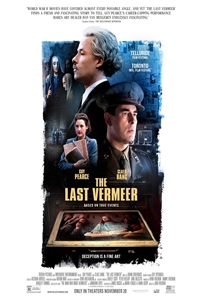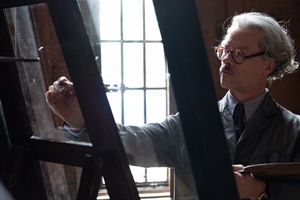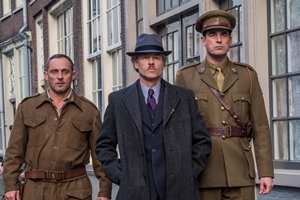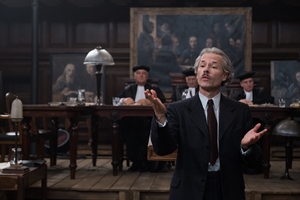Canada: Friday, November 20, 2020
Sony Pictures Classics
for some language, violence and nudity
http://www.sonyclassics.com/thelastvermeer/#
While Joseph Piller (Bang), a Dutch Jew, was fighting in the Resistance during the Second World War, the witty, debonair aesthete, Han van Meegeren (Pearce) was hosting hedonistic soirées and selling Dutch art treasures to Hermann Goring and other top Nazis. Following the war, Piller becomes an investigator assigned the task of identifying and redistributing stolen art, resulting in the flamboyant van Meegeren being accused of collaboration -a crime punishable by death. But, despite mounting evidence, Piller, with the aid of his assistant (Krieps), becomes increasingly convinced of Han's innocence and finds himself in the unlikely position of fighting to save his life.
Cast & Crew
Movie Cast
Movie Crew
User Reviews
Public Reviews - 1 Reviews
-
Gregory M. - Rated it 3 out of 5
"The Last Vermeer" While Captain Joseph Piller (Clais Bang), a 'Dutch Jew', is fighting in 'The Resistance' during 'The Second World War', the witty, debonair aesthete, Han van Meegeren (Guy Pearce) is hosting hedonistic soirées and selling 'Dutch' art treasures to Hermann Goring (Tom Dab) and other top 'Nazis'. Following the war, Piller becomes an investigator assigned the task of identifying and redistributing stolen art, resulting in the flamboyant van Meegeren being accused of collaboration a crime punishable by death. But, despite mounting evidence, Piller, with the aid of his assistant Minna Holmberg (Vicky (Krieps), becomes increasingly convinced of Han's innocence and finds himself in the unlikely position of fighting to save his life. Piller’s journey is trying to figure out what's right and what's wrong, and in the process he finds that he needs to forgive, forgive himself, and forgive his wife for what she may have done during the war. Piller needs to face certain things and say, that's what the war did to us, and people did what they had to do because they're just trying to survive. When Piller meets van Meegeren, he’s quite blunt and doesn’t really like him, but Piller asks himself, 'how can I look myself in the eye, or face my son, if I let this innocent man be hanged'? He thinks that if he can help this man, then perhaps he’ll be able to make peace within himself. Which is why he sort of loses himself along the way. And maybe there's no coming back to the old self, but perhaps there's a new self to discover. Piller set out on a journey to find something specific and finds himself. Han van Meegeren is a terrific character. He's at first considered an absolute villain in 'The Netherlands' for what he’d done, and then later, he's considered a real folk hero. What drives him to do what he did, his failed life as an artist. We've to understand how he could have stumbled as badly as he did. It’s really sort of mind-boggling. Maybe van Meegeren’s failure as an artist isn't so much about his skill and ability, but his own internal negative psychology that in a way doomed him. Some people don’t deal with success well; they may claim they want it, but they’re also their own worst enemy. Maybe not fitting into what's popular in the art world got him rejected by 'The Dutch' artistic community. He apparently takes the criticism to heart, and imploded. We all do things that we need to do, and it’s hard to judge how people deal with a set of events, since we all deal with things differently. We do what we can to survive. The part of van Meegeren that could adapt to certain situations is part of what’s fascinating about him, it’s his form of survival. But it also ultimately gets him, because we all must look in the mirror, and a big realization he has is that he too is a fake. He has come to embody it. There are two instances when, as the truth in the story is being revealed, as if van Meegeren are looking over to see how he's being perceived by Minna, looking at her to say, ‘look, I told the truth'! It's as if van Meegeren is seeking recognition from Minna. It’s a very subtle look in a very fast moment, but it's a meaningful exchange. The character of Minna represents an unerring barometer for Joseph Piller as he works to figure out if it’s true that to do a great right, do a little wrong. She’s a bit of an enigma, who's this woman in Joseph Piller’s life, and what does she do in her own life that got her here? She’s not Piller’s wife of course, she’s working with him, and she symbolizes the middle ground in Piller’s life and in his pursuit of what van Meegeren did and who he's. If one looks at portions of a story and tries to make sense of it as you try to assemble a puzzle, someone like Minna says, ‘let’s take a step back, and you’ll see the whole picture'. Perhaps that’s more of a female talent, stepping back and seeing the whole picture and bringing things together, and not getting distracted by all the little pieces. Joseph Piller is trying to discern what's good and what's bad. Minna introduces the idea to him of being open to the idea that maybe we don’t know what’s wrong and what’s right. Her mission is to keep him from the extremes. They may sometimes avoid the memory of certain things, or leave certain experiences out of their recollections, which makes it impossible to move on. There were seven 'Vermeer' paintings Han van Meegeren sold to 'The Nazis' between 1936 and 1942; every one of them was highly valued by Hitler’s top officers. Amongst Dutch war profiteers and those accused of being sympathetic to the enemy, van Meegeren was considered a big fish. The past no longer exists, the showy, decadent, louche van Meegeren, whose early career was cut short when 'The European' art world soundly rejected his work, was arrested in 1945 and put on trial for, essentially, crimes against two different pasts: The war years, when people did what they had to do to survive, and a time two centuries earlier, when Vermeer painted his masterpieces. Alcohol and chemical tests would have proved the age of the paintings van Meegeren sold to 'The Nazis'. But 'The Dutch Ministry Of Justice, the public thirst for retribution against those who profited from others’ pain, and the various military presence in 'The Netherlands' were sure of his guilt. Until Joseph Piller was convinced of the 57-year-old painter’s innocence as he came to trial late in 1947. The resulting trial, in a makeshift, ramshackle courtroom and it's amazing resolution made van Meegeren a folk hero. He died on December 30th, 1947, just weeks after his tribulations ended. "The Last Veemeer" recreate an era in 'European' history when cities and countries were being divided up by victorious 'Allied' powers. The very nature of art is enigmatic, how it’s created, why it moves us, and what classifies it as great in the eyes of experts and in history. The value a civilization puts on it's art and it's artists reflects itself, and how it views it's inner life and values. Thus certain artists are linked with their homeland, whether by choice, politics, or birth: Spain with 'Picasso'; Italy with 'Da Vinci' and the other 'Renaissance' artists; Russia with 'Kandinsky' and 'Chagall'; France with 'Monet' and 'Renoir'. As it's with 'The Dutch' master Johannes Vermeer (1632 - 1675), whose exquisite works played an unexpected role in 'The Netherlands' in the immediate aftermath of 'World War II', and, as seen in "The Last Vermeer", in the fate of an artist, and a resistance fighter-turned soldier, as their shared country looking to expunge the memory of 'Adolf Hitler’s Third Reich'. The soldier is Captain Joseph Piller, whose experiences as a 'Jew' and as a 'Freedom Fighter' in 'The Dutch Resistance' has delivered him through the war with a stark sense of right and wrong, of legality and immorality, and positioned him as a stolid delineator of truth. The artist is Han van Meegeren, a flamboyant painter whose early artistic failures early are now buried over by a life of flamboyance and opulence. Assisting Piller is Minna, a young art historian and scholar whose view of the power of the past, and the potential of future mistakes, helps guide Piller through their own complex era. The heartbeat of "The Last Vermeer" is the question of, what's art and what makes something a fake or not. People can create convenient answers for that. And sometimes, it’s a moral consideration or a decision that impacts the value of art. The film is fascinated with that, and these are issues which we've been thinking about and deliberating over for a long time. Joseph Piller is trying to determine what’s right or wrong, and Han van Meegeren contains another layer that's specific to him, and it all stems from those undercurrents. The nature of truth is something very crucial to what we’re seeing today. It’s always been very interesting how quality is subjective, how the driving up of prices in the art world, for instance, is connected to what someone says a piece of art is worth. Joseph Piller is a man who comes out of the war, and he’s used to a black-and-white way of thinking, which is perhaps a problem for him. He thinks you can divide people into the bad ones and the good ones. He's tasked with a job that requires looking at the possibility of the truth from several levels, and is working in opposition to 'The Dutch Ministry Of Information', which, in rooting out 'Nazi' sympathizers, has an intention that may, in it's zealotry, be adopting the methods of it's enemies. In doing his own job, Piller is pursuing the truth and trying to make sure that those who should be punished are indeed punished. But then Piller decides that he can’t punish van Meegeren, because van Meegeren, in some respects, did nothing wrong. As for van Meegeren on the surface, his own vulnerability is what he’s most afraid of, and so that’s what he recognizes, and in fact uses, in others. As we know, sometimes the way for powerless people to feel powerful is to dominate other people. It’s that idea that con men commit cons because they feel conned themselves. So in any situation, van Meegeren ingratiates himself or flatters. As for how that’s reflected in his paintings, an artist’s style says things about their psychology. In 1945, the crafty, felicitous van Meegeren owns nearly 600 properties just in Amsterdam. He makes an exorbitant amount of money. He lives the high life. Perhaps his humiliations as a young artist are so intense, he's determined to never struggle again. And, at a moment when a civilization-threatening conflict is over, the notion that a single truth could be shared by those from disparate parts of society is reflected in Piller’s fight to save van Meegeren. After the war is over, one emotion that people are feeling is, we’re still here, and sometimes it’s good to realize that we’re not alone. It's a symbolic moment. The story of Han van Meegeren and Joseph Piller vividly portrays how an evolution in thought is sometimes needed to understand good, evil, and the places where all of those ethical colors blend into each other. And really it’s a microcosm of the entire country after 'WWII', and the shift on society we saw. Piller an everyman, art world is beyond him, but also regrouping after a war is beyond him. It’s a very interesting time and place. It's meditation on how art, truth, and morality encompasses not just the story’s post-'World War II' setting, but the nature of classic art and it's importance to civilization’s soul. written by Gregory Mann




